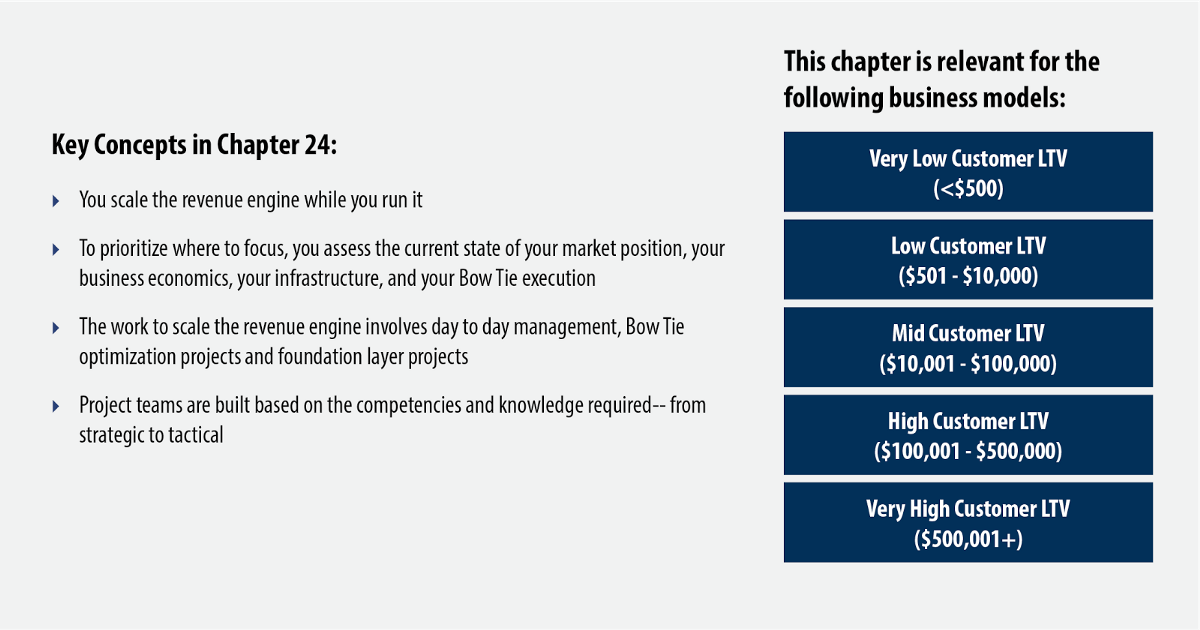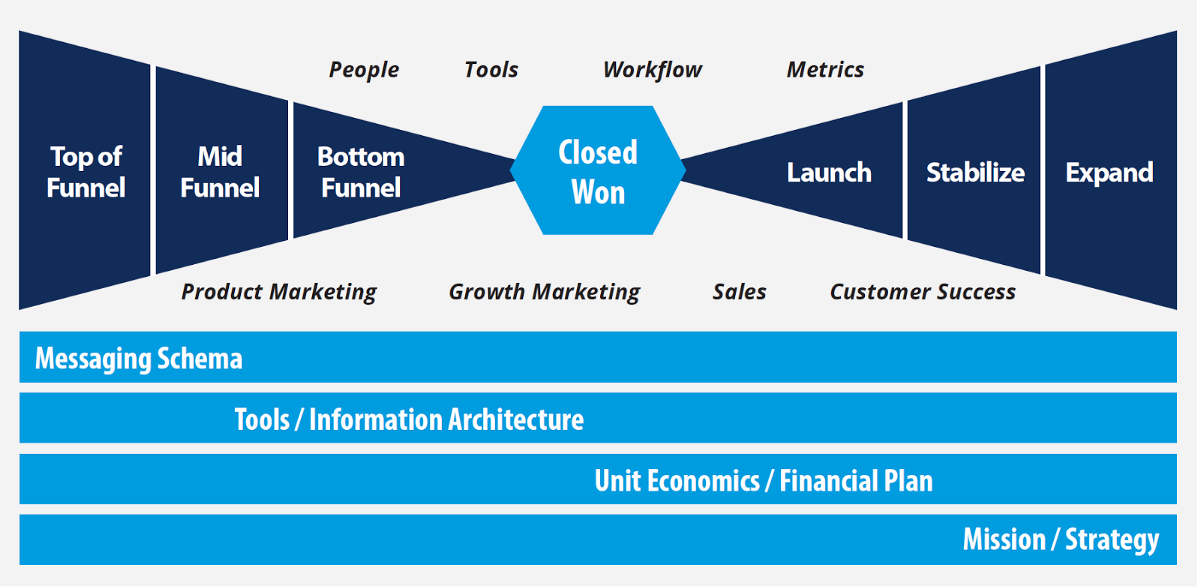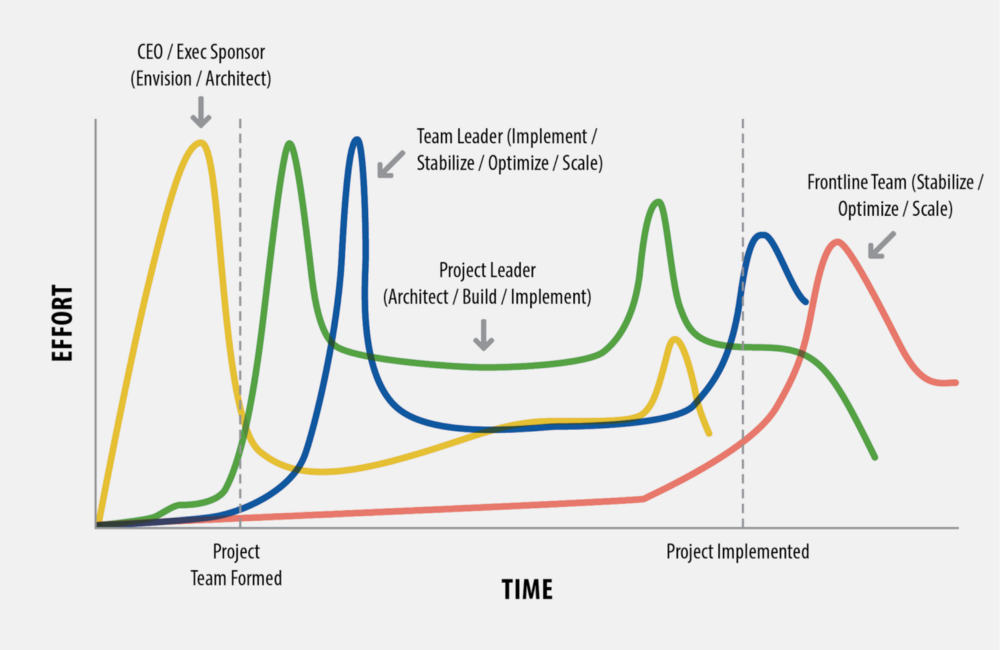As you redesign the revenue engine, you must run it.

Over the past 23 chapters, we’ve painted a picture of revenue engine best practice. Now it’s time to answer the question, “how do you get there?” The answer is simple. You scale the revenue engine while you run it.

Your revenue engine is a whole system, bounded by unit economics. Workflows, tools, data, and people must work together to orchestrate effective prospect and customer engagement. Functional managers and frontline employees must manage the handoffs from workflow to workflow. When executed well, you maximize reach at Top of Funnel and relevant messaging leads to vision lock. You drive conversion and sales cycle compression at Mid and Bottom Funnel, which leads to conviction lock. With proactive interventions as you Launch, Stabilize, and Expand, you guide the customer to advocacy lock.
But it’s never that easy. The engine coughs and sputters. Components are missing, or they break. Frontline employees encounter workflow bottlenecks. Prospects slip off the hook. Customers get frustrated and cancel. Marketing campaigns fail. Salespeople fall short of sales goals. Week by week, you find yourself playing a never-ending game of “whack-a-mole.”
It’s so very easy to be consumed by these day to day fires.
As CEO, you can find yourself barely keeping pace with the crisis du jour. But firefighting doesn’t provoke fundamental change. To create fundamental change, you must stand back from the chaos.
Take stock. Determine what change is required. Then get down to it.
Taking Stock
It starts with your market position. Are you so far in front of the wave you haven’t been able to catch it? Are you languishing in its wake? Or are you surfing at its crest? It’s important to know. Take an outside-in view:
- Seek the insights of your board of directors — what are their perspectives?
- Regularly engage a customer advisory board — what do customers see on the horizon?
- What do key industry analysts say about you?
- Listen carefully to your marketing and sales teams — what do they hear, and what friction are they discovering?
- Review conversion and churn metrics — what are the trends?
- Listen in on customer calls — what are the objections and complaints?
- Visit customers in their setting — is your product aligned with the customer’s reality?
- Go to trade shows — is yours the hottest booth at the show?
- Engage in thought leadership, and read the thought leadership of others in your field — are you ahead of the innovation wave or trying to catch up?
This outside-in data will inform your mission and strategy (customer segmentation, value proposition, competitive positioning, brand identity, product, pricing and packaging, prospect and customer journey, and channel architecture).
Then consider the economics of your business and the status of its infrastructure (unit economics, financial plan, tools, information architecture, and messaging schema).
Finally, take a look at each domain of the Bow Tie journey, from Top of Funnel to Expand.

What’s the status?
To make these assessments, it’s helpful to conduct a revenue engine assessment (see Chapter 2 — Revenue Engine Maturity Model). You can assess each component of the revenue engine, using the Carnegie Mellon Capability Maturity Model 1–5 rating system:¹
- Chaotic: workflows unpredictable, poorly controlled and reactive
- Project Centric: broken workflows fixed one at a time; often reactive
- Whole System: workflows linked end to end; proactive approach
- Quantitative: workflows measured and controlled
- Continuous improvement: ongoing, data-driven fine-tuning
Once you have identified the strengths and weaknesses of your engine down to the component level, you can force-rank the weak points.

Scaling the Revenue Engine
Revenue engine scaling falls into three categories of work:
- Day-to-day management — all activities in your company
- Bow Tie optimization projects — Top of Funnel, Mid Funnel, Bottom Funnel, Launch, Stabilize, and Expand domains
- Foundation layer optimization projects — Mission/Strategy, Unit Economics/Financial Plan, Tools/Information Architecture, and Messaging Schema
Day-to-day management is where the rubber hits the road. This is the world of average MQL follow-up response times or the time it takes from the opening of a customer support case to its resolution. It’s the number of cold calls per day, the launch of the next email campaign, and the completion of the day’s scheduled demo presentations.
Execute management of day-to-day work as close to the real workflow as possible. In the best run companies, frontline employees take a primary role in managing daily execution. At handoff points in the workflow, frontline employees work across functional boundaries to identify bottlenecks. Self-managed teams review metrics for continuous improvement.
Bow Tie optimization projects tend to be more tactical than strategic compared to others. At Top of Funnel, a project might be an A/B test on an email campaign, or a ramp-up of spending for a promising marketing channel, or the launch of a new ad campaign. At Mid Funnel, it might be the rollout of new SDR training or a hiring project. At Bottom Funnel, it might be an update to an email nurture campaign. At Launch, a project may be initiated to document new technical integration protocols. At Stabilize, a new customer best practice email campaign may be initiated to address a new use case scenario. At Expand, a new incentive program for CSMs or AEs might need to be rolled out. These projects are the stuff of routine marketing and sales management and, when executed well, they have meaningful short-term impacts on results. Mid managers are usually well positioned to lead Bow Tie optimization projects.
Foundation layer projects are more strategic than those in the Bow Tie. You might need to revisit your segmentation scheme and ideal customer profile (ICP). Or you might need to redesign pricing and packaging. Or your channel strategy. Or your messaging schema. Or rebuild your information architecture. These are heavy lifting projects that take executive vision, coordinated planning, and multi-level, cross-functional implementation.
Because the results of foundation layer projects are usually back-end loaded, it’s easy to de-prioritize them. Resist that temptation. The leverage that these projects can yield is orders of magnitude greater than Bow Tie optimization projects, even though their impact may take more time to realize. Foundation layer projects involve a sequential series of steps:
- Envision the end state
- Architect plans to achieve the end state
- Build to the plan
- Implement
- Stabilize
- Optimize
- Scale
These steps require coordinated handoffs of leadership throughout a project, as follows:

As CEO, you are the “chief envisioner.” Most of the time you’ll engage the executive team, seeking consensus on the vision. Once you have clarity as to the change you want to create, you can assign an executive sponsor and a project leader to drive it forward from “architect” to “build” to “implement.” Others may become involved once the project moves through “implement,” “stabilize,” “optimize,” and “scale.”
Once you’ve prioritized your foundation layer projects, stick with them. Press forward until you’ve achieved your key project milestones, then move on to the next one. By doing so, you slowly but steadily strengthen your revenue engine. In time, your engine will become highly efficient and robust.
Summary
No matter the state of your revenue engine, it can always be improved. Whether you are an early stage startup, a mid-stage growth startup or a public tech company, your work to scale the revenue engine is ongoing.
Regardless of business model, the core principles of scaling remain the same.
Conceive of your revenue engine as a whole system. Think through how your marketing, sales, finance and product teams will work together. Orchestrate the prospect and customer experience. Understand your unit economics boundaries, and the levers available to you given your business model. Make sure you have in place the data and infrastructure to scale. Do the work to create and execute a winning strategy.
As a tech company CEO, you are the captain of your destiny. Will you build a great company? One that has a profound impact in your chosen field? Will you heartily reward your investors, your employees, and yourself with the fruit of your hard labor?
Your revenue engine is the means by which all of these things are achieved. Make yours a Porsche.
Zoom towards the sunrise on the road to freedom.
. . .
If you would like more CEO insights into scaling your revenue engine and building a high-growth tech company, please visit us at CEOQuest.com, and follow us on LinkedIn, Twitter, Facebook, and YouTube.
. . .
Notes:
- Carnegie Mellon Univ. Software Engineering Inst. The Capability Maturity Model: Guidelines for Improving the Software Process (SEI). Addison-Wesley Professional. 1994. Print.

